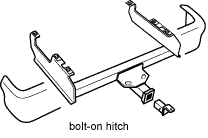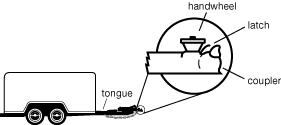See Hitch Ball.
Measurement from the ground to the center of the hitch ball or hitch ball coupling (trailer) when parked on a flat surface and parallel to the ground. Used to determine the amount of drop or rise needed in the ball mount to make the trailer ride parallel to the ground when being towed.
A removable hitch ball platform that slides into the Receiver of a hitch and fastens with a pin and clip. Different ball mounts can be used to raise or lower the height of the ball to allow for level trailer towing.
A device which attaches directly to the tow vehicle providing the connection between the tow vehicle and the trailer. A fixed tongue hitch includes the ball platform, while a receiver style hitch has a receptacle (typically 1-1/4" or 2") for inserting special ball mounts or bike racks.
Interface between tow vehicle and electric trailer brakes. Can be inertia activated or based on time delay from activation of vehicle brakes. Typically in the tow vehicle's driving compartment with electrical line running to the trailer wiring connector. Most require the user to adjust brake gain to compensate for varying trailer load. Necessary for the use of electric trailer brakes.
The parts on a vehicle that protect the front and rear ends in the event of an accident. Some trucks and SUVs have a tow bumper (or step bumper) for attaching a hitch ball for towing.
Trailer hitch with capacity of up to 2,000 lbs gross trailer weight and 200 lbs tongue weight.
Trailer hitch with weight-carrying rating of up to 3,500 lbs gross trailer weight and 300/350 lbs tongue weight.
Trailer hitch with weight carrying rating of up to 5,000 lbs gross trailer weight and 500 lbs tongue weight. Also sometimes used to refer to a hitch with any 2" receiver, regardless of rating.
Trailer hitch with weight carrying rating of up to 10,000 lbs gross trailer weight and 1,000 - 1,200 lbs tongue weight. Although many times any hitch with a capacity greater than 5,000 lbs gross weight is referred to as a Class 4.
Converts 3-wire tow vehicle electrical systems to 2-wire systems by integrating the stop and turn signal circuits as is common in trailer wiring.
The forward most part of a trailer Tongue that envelopes and secures to the tow vehicle hitch ball.
The empty weight of a vehicle full of fuel and all fluids. Curb weight does not include passengers or payload.
A hitch that is designed for a particular year, make and model of vehicle. Because these hitches are made for a specific vehicle, the best possible appearance can be achieved.
Also see: hitch, permanent undercar hitch, receiver style hitch, and round tube hitch.
A removable coupling platform that slides into a hitch receiver and fastens with a pin and clip, or the "tongue" portion of a fixed-tongue hitch. The term drawbar is sometimes used to distinguish a ball mount with a solid ball shank or a coupling configuration different than a hitch ball (such as a pintle hook).
Also see: Ball Mount
See weight distribution system.
A Class 5 hitch that mounts in the bed of pickup truck which uses a plate in the bed of the truck (similar to a semi-tractor) and a Pin on the trailer.
A Class 5 hitch that mounts a ball in the bed of a pickup truck (either 2-5/16" or 3" in diameter) to engage a coupler on a trailer. Not to be confused with a fifth wheel.
Total combined weight of the two coupled vehicles, including all passengers and payload.
The total weight of a trailer including all of its contents.
The total weight of a vehicle including all of its contents and passengers.
The weight specified by a manufacturer as the recommended maximum weight of a vehicle when fully loaded.
A device which attaches directly to a tow vehicle providing the connection between the tow vehicle and the trailer. Hitch installations are most often considered permanent. A fixed tongue hitch includes a flat non-removable drawbar, while a receiver style hitch has a receptacle (typically 1-1/4" or 2") for inserting special ball mounts or bike racks.
Also see: custom hitch, permanent undercar hitch, receiver style hitch, and round tube hitch.
The ball-shaped attachment to a hitch onto which a trailer coupler is attached.
See ball mount or drawbar
See Tongue Weight
Any item that slides into a receiver style hitch (i.e. ball mount, bike rack, winch).
A hitch pin that locks with a key to prevent theft of a ball mount or other insert.
A round metal ring used in place of a ball coupler on a trailer. It attaches to a pintle hook on the towing vehicle.
Original equipment manufacturer.
Used to fasten any insert (ball mount, bike rack) into a receiver hitch. Available in standard and locking configurations.
A common heavy-duty coupling type which utilizes a pintle hook attached to a tow vehicle to pull a trailer having a lunette eye. Pintle hitches are commonly used on military, construction, industrial and agricultural equipment.
The "jaw" portion of a pintle hitch which attaches to the tow vehicle.
An insert for a receiver hitch, having a shank with a flat plate to bolt a pintlehook to. These mounts are typically adjustable for vertical height.
The connector used to connect trailer wiring to a tow vehicle.
The receptacle part of a trailer hitch which accommodates inserts such as ball mounts, drawbars or accessory carriers. Common receiver sizes are 1-1/4" and 2".
A temporary receiver end-cap insertable into a 1-1/4" or 2" hitch receiver. Designed to protect from the elements. Also used to mask or enhance the look of the hitch when not in use.
Any hitch with a receptacle (typically 1-1/4" or 2") which accommodates inserts such as drawbars, ball mounts, or bike racks.
Also see: custom hitch, bolt-on hitch , hitch, and round tube hitch.
A new generation of custom hitches designed to produce a more pleasing visual appearance. The use of round tubing lowers the weight of the hitch while maintaining its strength. These hitches are designed to compliment the look of the vehicles for which they are made.
The chains that are attached to the trailer Tongue with hooks on their free ends. These chains keep the trailer connected to the tow vehicle should the coupler or hitch ball detach from the tow vehicle. Safety chains must be secured every time you tow.
A surge brake system is entirely self-contained on the trailer and is activated when the tow vehicle decelerates. The momentum of the trailer pushes the surge brake housing forward. This drives the push rod that is connected to the coupler into the master cylinder. Brake fluid is then forced out of the master cylinder into the wheel cylinders or pistons that apply the trailer brakes. The entire activation process is completed in less than one second. Hydraulic surge brake systems can be used by a variety of tow vehicles and can accommodate a variety of trailer loading conditions without requiring any type of adjustment.
A device similar to a shock absorber which resists swaying movement of a trailer tongue sometimes caused by passing vehicles and wind.
Two axles (four wheels).
The part of the trailer which extends forward from the trailer box and includes the coupler.
The downward weight applied by the towable equipment on the hitch ball. Generally tongue weight should not be more than 10% of the gross trailer weight.
Also see: weight distribution system.
A device attached to the front of a vehicle which allows it to be towed by another vehicle while riding on its own wheels.
The vehicle that pulls a trailer or towed vehicle.
An auxiliary cooler that is available to provide extra cooling for automatic transmission fluid. Lower temperatures equal longer transmission life.
Any hitch used without a weight-distributing system. Some hitches are designed and clearly marked "weight carrying only". Some hitches are weight carrying with weight distributing ability and will have a dual rating – "weight carrying (WC) 5000 / weight distributing (WD) 10,000", for example. To use a hitch at the higher rating (WD), a weight distribution system must be added.
Langley
20278 - 62nd Ave.
Langley, BC V3A 7Y4
Tel: 604-534-6200
Fax: 604-534-2056
Toll Free 1-888-40-HITCH
Email Us at : langley@ehhitch.com
|
Surrey
8155 - 128th Street
Surrey, BC V3W 4G1
Tel: 604-590-1776
Fax: 604-590-2893
Toll Free 1-888-99-HITCH
Email Us at : surrey@ehhitch.com
|




